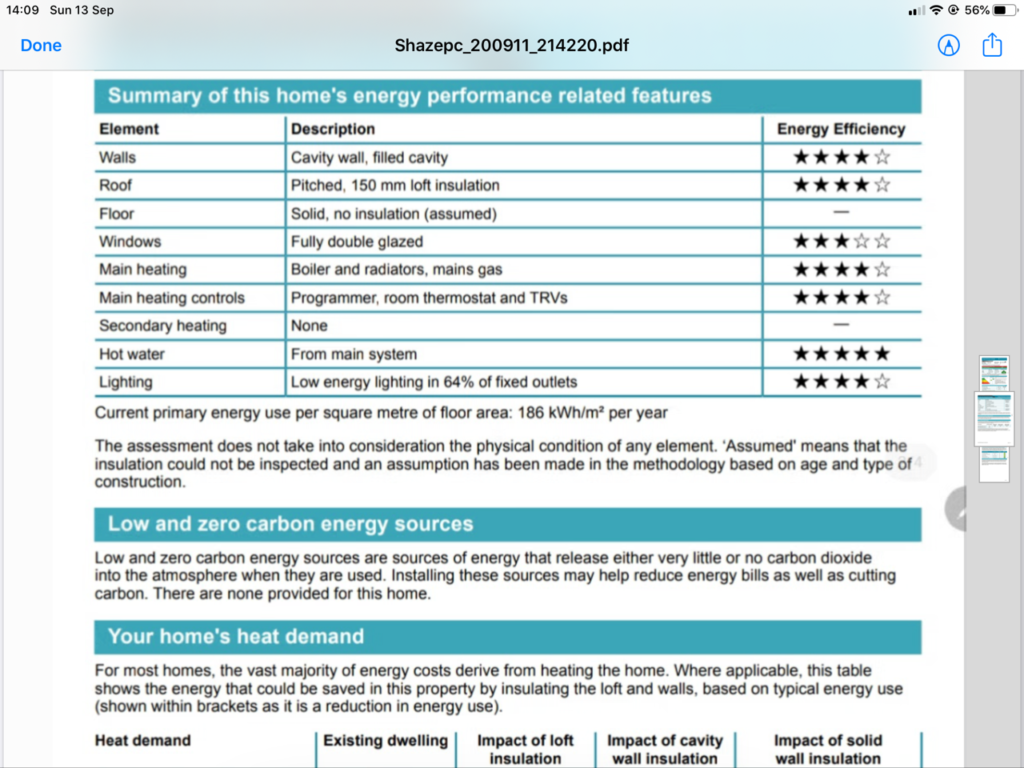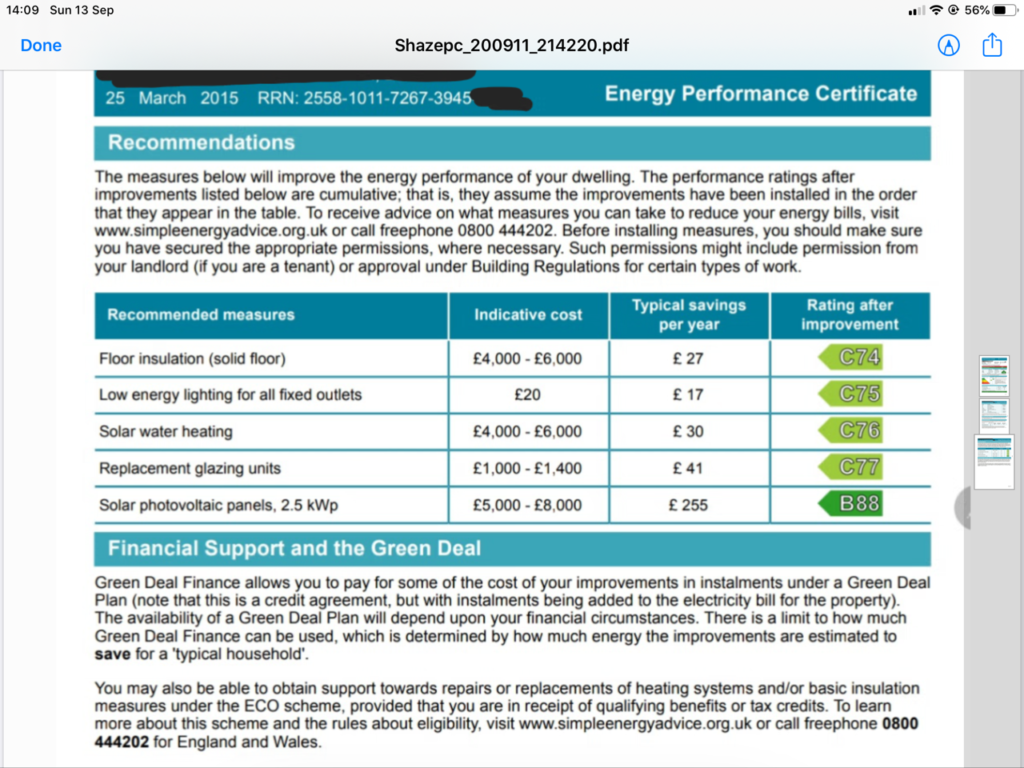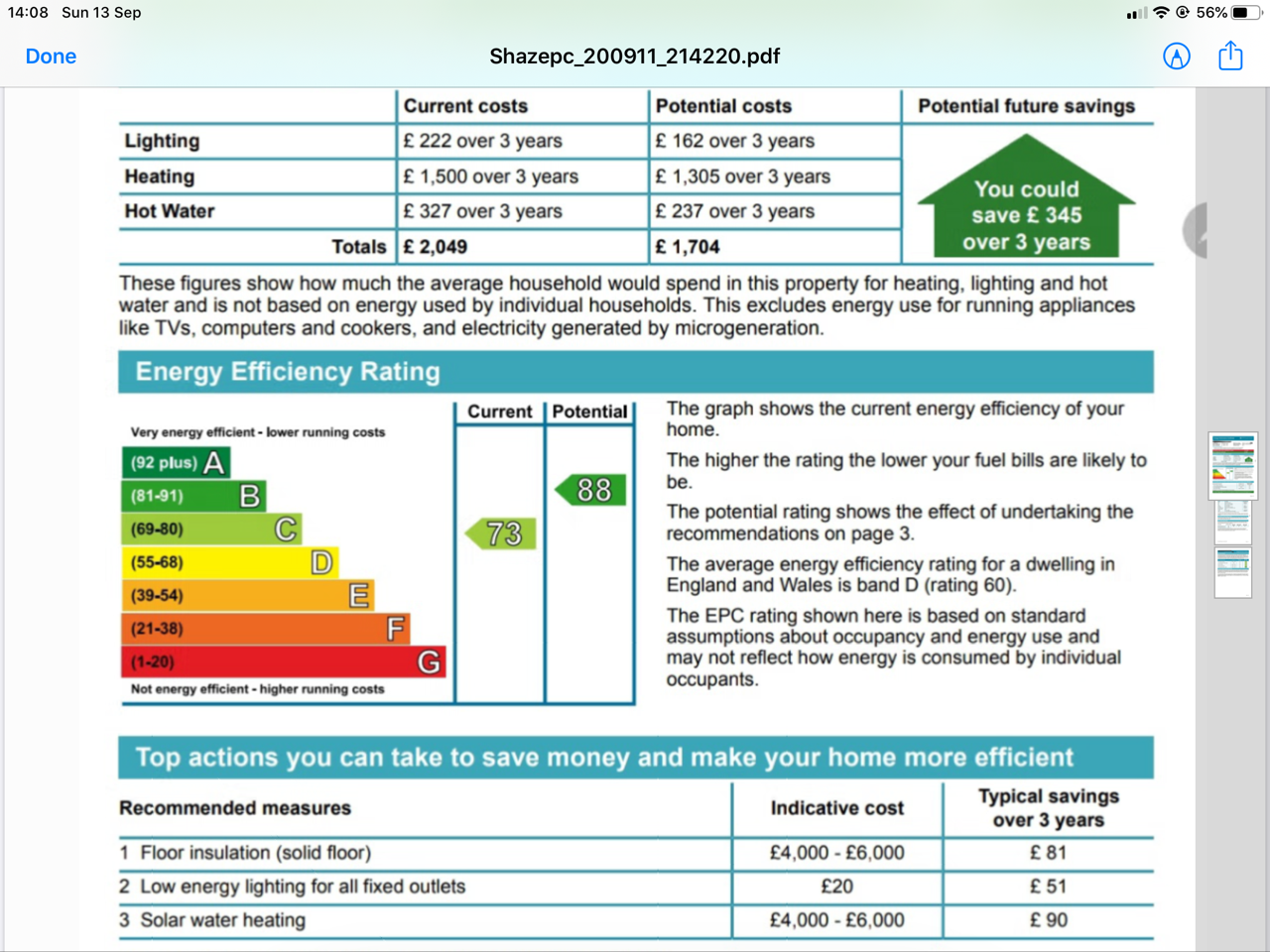What is an EPC?
In my day job I complete Energy Performance Certificates. An Energy Performance Certificate (EPC) measures the energy efficiency of a property. If you buy, sell a house or rent one, an EPC will be produced. They are valid for ten years. An EPC has a rating system between A and G with A being high. A property with an A rating will usually be new, with a very efficient heating system and also very well insulated. G rated properties are usually old, with low efficiency heating systems and are poorly insulated. It is important to note that EPC’s deal with averages. They can give you a good indicator on the energy efficiency of a property, but each property is different and will need individual expertise.
Example EPC
I’ve taken an example of an EPC and I shall talk you through how to best gather the information that you need from it. The example EPC is a three bed, mid terraced house with no extensions, built in 1968.
On page one of an EPC it gives you the headline information. On the example EPC it says what the estimated costs of lighting, heating and hot water are currently and what the savings could potentially be if the below recommendations on the EPC are implemented. I would not focus on the figures. Each property is different and energy usage also is incredibly important in terms of costs. Somebody who barely has the heating on will spend less than somebody who has the heating on all the time, even if the second person has a more efficient heating system. In the example EPC it says that you can save £345 in three years.
The next section on the first page has the rating of the property and the potential rating if all the recommendations were acted upon. My example EPC is C rated with a score of 73. It could potentially be 88 which is a B rating. A C rating is typical of a cavity wall property that has been cavity wall insulated and has relatively new combi gas boiler.
Below the ratings are the top three recommendations for the property. For this property they are; floor insulation, low energy lightbulbs and solar water heating. It also has estimated prices and potential savings for these measures.
A Home’s Energy Performance Related features

This section details the current energy efficiency of the features of the property using a five star rating system. In this example property the ratings are generally high. I’ll go through each feature.
Walls. This property has cavity walls which are cavity insulated. The report won’t say this but there are clear scar marks on the property for cavity wall insulation. A rating of four stars is given for this. As the property is a 1960’s property, practically this is the highest rating that the walls can achieve.
If the property was solid wall without insulation or cavity wall without insulation than the property would receive a lower star rating and would have a recommendation for either solid wall insulation or cavity wall insulation.
Roof. This property has 150mm loft insulation. As this example EPC is five years old it has four stars. If this EPC was done today it would probably receive a lower star rating. The recommendation for loft insulation is 270mm thickness.
Floor. Floor insulation. This property is assumed to not have floor insulation as it is a 1960’s property. If it was a new build property, some level of insulation would be assumed
Windows. The windows in this property are double glazed, but the windows are quite old so they only get three stars. If it was modern double glazing or even triple glazing, it would get a higher star rating.
Main heating. This property has a combi gas boiler. The boiler is relatively new and so it gets four stars.
Main heating controls. This property has a programmer and thermostat in one unit as well as having thermostatic radiator valves on each radiator. This means that the temperature on each radiator can be controlled individually. This gets four stars.
Secondary Heating. Secondary heating would cover things like an electric fire or gas fire in the living room that is not part of the main heating system. This property has no secondary heating
Hot Water. The hot water comes from the boiler. When the hot water tap is turned on; the combi boiler kicks in and produces hot water almost instantly. This is better than a separate water cylinder for hot water. It gets five stars.
Lighting. The higher the % of low energy lights the higher the rating. This property gets three stars for having 64% of lightbulbs being low energy,
Recommendations
On the third page of an EPC there will be a set of recommendations as to how to improve the energy efficiency of the property. It will tell you an approximate cost and how much the measure could save per year. It is important to assess whether the cost of the measure is worth the amount of money it can save you per year. Installing low energy lights is very cost effective, but installing floor insulation on a solid floor won’t save enough money to justify the costs of installing solid floor insulation. I’ve put the list of recommendations for this property below.

Picking Appropriate Recommendations
In these measures suggested; low energy lights would be worthwhile doing. The rest of the measures are expensive compared to the payback. Is it worth paying £4000-£6000 for solid floor insulation? Probably not. There are other reasons to have some of these measures installed that need to be considered. For example it could be good to replace the double glazing because the old double glazing is flimsy and could be easily broken into. The recommendations give you things to think about. Every property is different and would need an individual assessment to see what is worthwhile.
Other measures could include, cavity or solid wall insulation for properties without this already. Loft insulation for properties with less than 270mm. If the property has old, electric storage heaters, it may suggest new high heat retention storage heaters. In general, the loft, the walls, and the heating system are the biggest factors when determining how energy efficient a property is. Those are the measures that you should look at first when you first see the EPC.
An EPC gives you a rough guide as to the energy efficiency of a property. They can be a useful guide for how you can make a property more energy efficient.
This article originally appeared on the Help me I’m buying a house website. If you are looking to buy a house, this is a great book to seek advice from.
.








